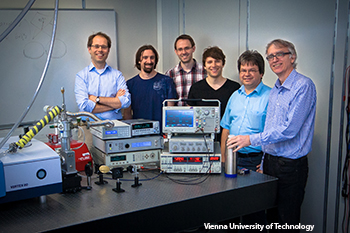
Vienna University of Technology laser team, from left to right: Stefan Rotter, Martin Brandstetter, Matthias Liertzer, Christoph Deutsch, Joachim Schöberl and Karl Unterrainer.
Everyone knows how energy gets pumped into a laser cavity to stimulate a burst of coherent light. By exploiting nonlinear optical theory, however, a research team in Austria has shown how a coupled pair of tiny lasers can do exactly the opposite.
As demonstrated by a group at the Vienna University of Technology (Nature Commun., doi:10.1038/ncomms5034), an increase in the pump power in a pair of microdisk quantum cascade lasers (QCLs) can shut off the laser beam and a drop in pump energy can switch it back on. The researchers hope the results will aid the development of photonic circuitry on the microchip level.
The group, led by Vienna professor Stefan Rotter, studied the quasi-bound resonances in open resonators and resonators with internal loss or gain. At certain places called “exceptional points,” the position and width of two resonances are the same. The researchers performed numerous computer simulations to figure out how to induce exceptional points by changing the amount of pump energy applied to the laser. A system of two coupled lasers turned out to be a good system to try experimentally.
The team fabricated two terahertz QCLs shaped like thin disks with the active semiconductor region sandwiched between two metal contacts. The emission wavelength of the QCLs was roughly the size of the microdisks—about 100 μm. The disks were placed side by side to induce mode coupling. The scientists measured the pump strength in one disk while holding the other disk at a constant pump value just about the threshold for laser action, and recorded the characteristic reversal in the first disk's pump dependence.
